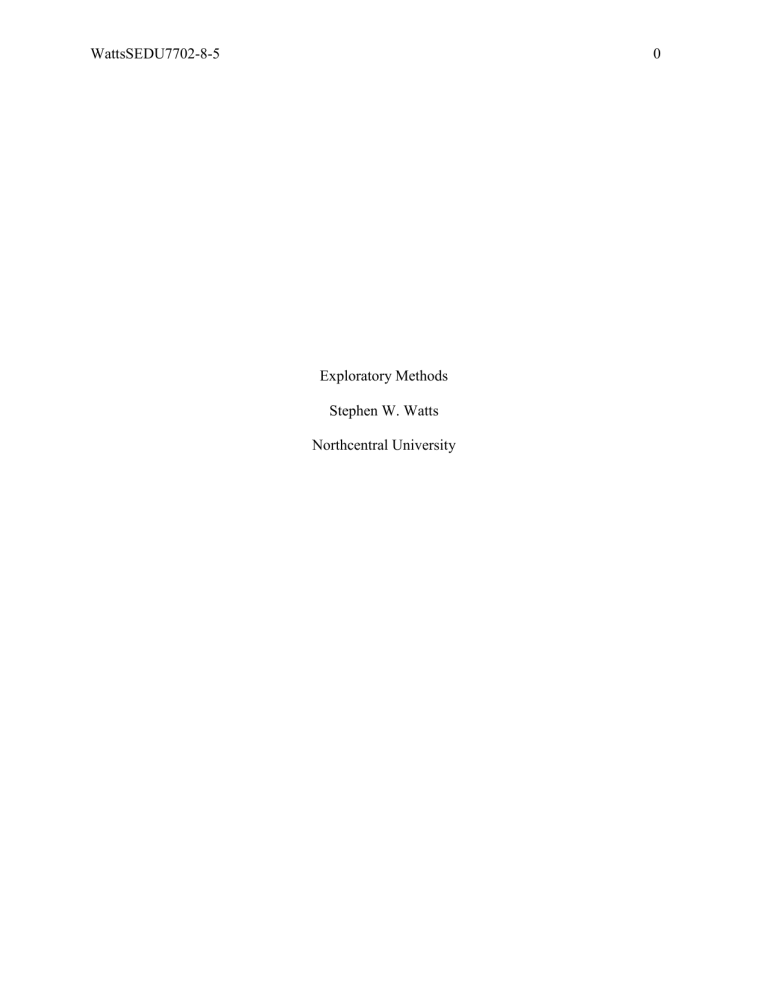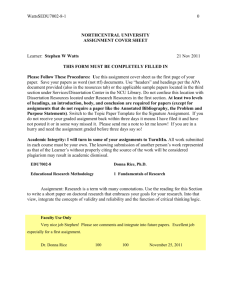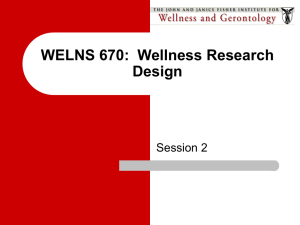When are case studies used?

WattsSEDU7702-8-5
Exploratory Methods
Stephen W. Watts
Northcentral University
0
WattsSEDU7702-8-5 1
Exploratory Methods
Qualitative studies generally examine complex phenomenon in natural settings and have many different approaches. Leedy and Ormrod (2010) identified four main purposes for qualitative research. One purpose is to expose the underlying nature of people or phenomenon and accurately describe it. The research can also discover insights, develop new theoretical perspectives, or identify problems regarding a specific phenomenon. Sometimes the purpose of research is to verify a phenomenon within the framework of theory, and in others to evaluate effectiveness (Leedy & Ormrod, 2010). Generally, the collection of data in qualitative studies requires much more time than quantitative studies because of the nature of the data collected and how it is analyzed (Leedy & Ormrod, 2010; Salkind, 2009).
Case Studies
What is a case study?
Cozby and Bates (2012) defined a case study as “an observational method that provides a description of” (p. 121) a phenomenon. The phenomenon studied can be “a specific individual or specific context” (Trochim & Donnelly, 2008, p. 147). Direct observation of the research is often utilized by investigators using case study methodologies (Salkind, 2009), but is not essential to a case study. Case studies are based on the collection of large amounts of data regarding the phenomenon under study (Creswell, 2009; Leedy & Ormrod, 2010). Each case study is unique and may be conducted using different techniques and methods than any other
(Trochim & Donnelly, 2008). In a case study it is essential for the researcher to record the phenomenon under study and its context (Leedy & Ormrod, 2010). From several sources it is apparent that case studies are used to document in-depth the characteristics, traits, habits, personality, and interactions of people with unique or rare conditions. Case studies are also used
WattsSEDU7702-8-5 2 in observing, evaluating, and describing programs. Case studies are an excellent way to begin investigating a phenomenon to formulate postulates and theories regarding a behavior. With the exception of purely descriptive case studies, the main benefit of case studies is in their ability to contribute to theory (Harlow, 2012).
When are case studies used?
Case studies are useful in situations where theory has not been developed; scenarios where knowledge or understanding is minimal or non-existent (Leedy & Ormrod, 2010). If a phenomenon is unique, rare, noteworthy, or unusual it may call for a case study (Crosby &
Bates, 2012). Case studies attempt to document as much information about the person or thing studied as possible, resulting in a fuller account of the phenomenon than any other research methodology (Salkind, 2009). Case studies are useful in discovering changes to people or programs over time (Leedy & Ormrod, 2010).
Research utilizing case studies is very popular in the field of e-learning as authors and investigators attempt to formulate theories and determine best practices. This popularity led
Gunawardena, Linder-VanBerschot, LaPointe, & Rao (2010) to express the need to move beyond case studies to determine the characteristics of training that increase learning outcomes, satisfaction, and transfer. Still, Cabrera-Lozoya, Cerdan, Cano, Garcia-Sanchez, and Lujan
(2012) identified their quantitative study regarding “the creation, development, and implementation of heterogeneous learning environments” (p. 617) a case study. The authors stated their belief that by creating a generic, real-time, in class means of interaction between students and instructor, student’s participation and academic performance would markedly improve. They found that CADI, their learning environment, provided appropriate diversity in establishing an additional immediate communication channel between student and instructor in
WattsSEDU7702-8-5 3 the classroom. The authors also found that the system did increase student participation and resulted in a one point improvement (out of 10) of average grades when contrasted with previous years. This study met the criteria of a case study because it studied in-depth a single class using a specific learning tool which could then be compared with three previous years of that class that did not utilize the learning tool.
Another recent case study used a naturalistic approach and documented the teaching practice of online instructors and the learning experience of online adult students (Ke, 2010). Ke used interviews, artifact analysis, content analysis, and surveys to collect data; consistent with a multi-technique approach often used in case studies. The authors findings were that “an effective teaching presence with supportive features to reinforce the emerging of cognitive and social presence in an online learning environment” (p. 818) is important for creating an engaging atmosphere. He also found that online discussions play an ambivalent role in student performance and student engagement, but that “instructors who demonstrated high presence online [were] key to learning satisfaction” (p. 818).
A final example of the use of a case study regarding online learning was conducted by
Hrastinski and Jaldemark (2011). The authors stated that they utilized a case study approach because it allowed them to use “several complementary sources of evidence and because findings can be cross-validated through triangulation” (p. 257). The specific techniques used by
Hrastinski and Jaldemark were to analyze electronic logs of online communications both quantitatively and qualitatively, as well as semi-structured telephone interviews with about 40% of the students. The authors found that there are significant difference is participation when utilizing asynchronous versus synchronous modes, but also that the intent of messages between the modes were also different. Asynchronous tools encouraged greater exchange of information
WattsSEDU7702-8-5 4 and staying on task, and were more likely to be dominated by a few participants, while synchronous tools were more equally distributed and messages centered more on the management of tasks and social support. These three examples of case studies demonstrate the variety of research studies that can use this methodology.
What is a psychobiography?
Psychobiography is a form of case study that uses psychological theory and analysis to write biographies regarding historical figures (Crosby & Bates, 2012). In a library search for psychobiographies relating to the field of e-learning, no results were found. This is consistent with the relative newness of the field, and the lack of iconic pioneers for which a psychobiography may be appropriate.
Archival Research
What is archival research?
An archive is a means of collecting and storing documents. Archival research consists in researching the documents stored in an archive. Leedy and Ormrod (2010) discuss archival research as a form of historical research where “the researcher makes every effort to find firsthand accounts and artifacts of an event” (p. 165). Existing documents can provide an incredible depth of information to researchers to corroborate or challenge data collected in other ways (Salkind, 2009). Archival data can take the form of primary data, such as letters, tools, buildings, diaries, films, sermons, paintings, census reports, photographs, and civil records
(Leedy & Ormrod, 2010).
What are the major sources of archival data?
Any collection of documents or artifacts constitutes an archive, but the most utilized archives in research are statistical records, archives of surveys, and written records (Crosby &
WattsSEDU7702-8-5 5
Bates, 2012). Archival data can be difficult to work with because records may be difficult to access and the reliability of the data can be called into question since the researcher did not supervise its collection (Crosby & Bates, 2012). In e-learning an archive is more likely to consist of course materials, lectures, slide shows, discussions, or white boards for asynchronous student retrieval (Er, Ozden, Arifoglu, 2009; Gunawardena et al., 2010). Some studies utilize archived online student interaction scripts (Ke, 2010), on-line discussions through archived written notes (Nummenmaa & Nummenmaa, 2008), or e-mail messages (Tallent-Runnels,
Thomas, Lan, Cooper, Ahern, Shaw & Liu, 2006) for analysis of patterns or themes.
Content Analysis
What is content analysis?
Content analyses are used to identify patterns and themes in the documentation of a specific corpus of material through a methodical and thorough examination (Crosby & Bates,
2012; Leedy & Ormrod, 2010). Content analysis was labeled by Trochim and Donnelly (2008) as an unobtrusive measure, meaning that live subjects are unnecessary. Typically there are four steps to conducting a content analysis; (a) criterion for inclusion or exclusion from the body of material, and an appropriate sample is selected, (b) criterion is defined regarding the qualities or characteristics to find, (c) the sample is broken into manageable fragments to be analyzed independently, and (d) the material is perused, judged, and tabulated according to the criterion
(Leedy & Ormrod, 2010). A content analysis should be planned, designed, and conducted so the process is as objective as possible (Leedy & Ormrod, 2010).
Research in online learning can utilize content analysis. Ke (2010) used content analysis on online discussion transcripts focusing on “cognitive and social presence in the online environment, using a quantitative analysis framework” (p. 810). He used thematic units as his
WattsSEDU7702-8-5 6 unit of analysis with each unit categorized into eight themes and three dimensions; social interaction, knowledge construction, and the regulation of learning. Dzubian and Moskal (2011) used a content analysis to compare historical evaluation of instruction surveys in relation to faceto-face, online, and blended courses to determine “the underlying factor patterns of student responses to their courses in those three modalities” (p. 237). According to factor invariance if the same instrument is used in different contexts it may successfully measure different constructs. Therefore if face-to-face, online, and blended instruction is based on differing learning constructs, these should be reflected in the evaluations. This study, with over one million student responses, demonstrated that regardless of the mode of instruction there is only a single evaluation dimension and “course modality is not a treatment in the experimental or even quasi-experimental case” (p. 240). Chen and Lien (2011) used a specific form of content analysis called an author co-citation analysis to identify “the intellectual structure of e-learning”
(p. 867). Their unit of analysis was the bibliographic element and the analysis consisted of determining the relationships between authors by quantifying the times authors are cited together. They then used multi-dimensional scaling and hierarchical agglomerative clustering to graphically present these relationships. They determined that Taiwanese author’s focus on three themes; (a) application in business, (b) implementation of e-learning, and (c) conceptual study of e-learning. International authors tend to spotlight three different themes; (a) adaptive web-based learning, (b) the usage of IT in learning activities, and (c) psychological research for using IT in learning. Chyung and Vachon (2005) performed a content analysis to build theory and guidelines from course evaluation data of 17 e-learning courses. After the data analysis of qualitative input, 19 categories were derived. These categories were then prioritized based on student emphasis on whether the category was a satisfying factor, or a dissatisfying factor. The
WattsSEDU7702-8-5 7 most frequent satisfying factors were learning oriented, while the most frequent dissatisfying factors were impediments to goal achievement. In all of these examples, large amounts of data were analyzed to find patterns regarding online learning, which is the primary advantage of content analysis.
Conclusion
Qualitative research can be conducted in more than a dozen ways. Qualitative research allows investigators the ability to dig deeply into a single case or context as with case studies, to utilize psychological analysis and theory to determine the motivations and personality of historical figures, can delve into documentation collected into archives to get a more complete picture of an event, or can use historical data to find patterns and themes as a precursor to developing theory. Qualitative research takes a great deal of planning, organization, inventiveness, and time, but it can also create a body of literature that aids in establishing the veracity of theory and best practices.
WattsSEDU7702-8-5 8
References
Cabrera
‐
Lozoya, A., Cerdan, F., Cano, M.
‐
D., Garcia
‐
Sanchez, D., & Lujan, S. (2012). Unifying heterogeneous e
‐ learning modalities in a single platform: CADI, a case study. Computers
& Education, 58 (1), 617
‐
630. doi:10.1016/j.compedu.2011.09.014
Chen, L.-C., & Lien, Y.-H. (2011). Using author co-citation analysis to examine the intellectual structure of e-learning: A MIS perspective. Scientometrics, 89 , 867-886. doi:10.1007/s11192-011-0458-y
Chyung, S. Y., & Vachon, M. (2005). An investigation of the profiles of satisfying and dissatisfying factors in e-learning. Performance Improvement Quarterly, 59 (3), 227-245. doi:10.1177/0741713609331546
Cozby, P. C., & Bates, S. C. (2012). Methods in behavioral research (11th ed.). Boston, MA:
McGraw Hill Higher Education.
Creswell, J. W. (2009). Research design: Qualitative, quantitative, and mixed methods approaches (3rd ed.). Thousand Oaks, CA: SAGE.
Dziuban, C., & Moskal, P. (2011). A course is a course is a course: Factor invariance in student evaluation of online, blended and face-to-face learning environments. The Internet and
Higher Education, 14 (1), 236-241. doi:10.1016/j.iheduc.2011.05.003
Er, E., Ozden, M. Y., & Arifoglu, A. (2009). LIVELMS: A blended e-learning environment: A model proposition for integration of asynchronous and synchronous e-learning.
International Journal of Learning, 16 (2), 449-460. Retrieved from http://ijl.cgpublisher.com/product/pub.30/prod.2066
Gunawardena, C. N., Linder-VanBerschot, J. A., LaPointe, D. K., & Rao, L. (2010). Predictors of learner satisfaction and transfer of learning in a corporate online education program.
The American Journal of Distance Education, 24 (1), 207-226. doi:10.1080/08923647.2010.522919
Harlow, E. (2009). Contribution, theoretical. In A. J. Mills, G. Durepos, & E. Wiebe (Eds.),
Encyclopedia of Case Study Research (pp. 237-239). Thousand Oaks, CA: SAGE.
Ke, F. (2010). Examining online teaching, cognitive, and social presence for adult students.
Computers & Education, 55 , 808-820. doi:10.1016/j.compedu.2010.03.013
Leedy, P. D., & Ormrod, J. E. (2010). Practical research: Planning and design . Upper Saddle
River, NJ: Merrill.
Nummenmaa, M., & Nummenmaa, L. (2008). University students' emotions, interest and activities in a web-based learning environment. British Journal of Educational
Psychology, 78 , 163-178. doi:10.1348/000709907X203733
WattsSEDU7702-8-5 9
Salkind, N. J. (2009). Exploring research (7th ed.). Upper Saddle River, NJ: Pearson/Prentice
Hall.
Tallent-Runnels, M. K., Thomas, J. A., Lan, W. Y., Cooper, S., Ahern, T. C., Shaw, S. M., &
Liu, X. (2006). Teaching courses online: A review of the research. Review of Educational
Research, 76 (1), 93-135. doi:10.3102/00346543076001093
Trochim, W. M. K., & Donnelly, J. P. (2008). The research methods knowledge base (3rd ed.).
Mason, OH: Cengage Learning.







